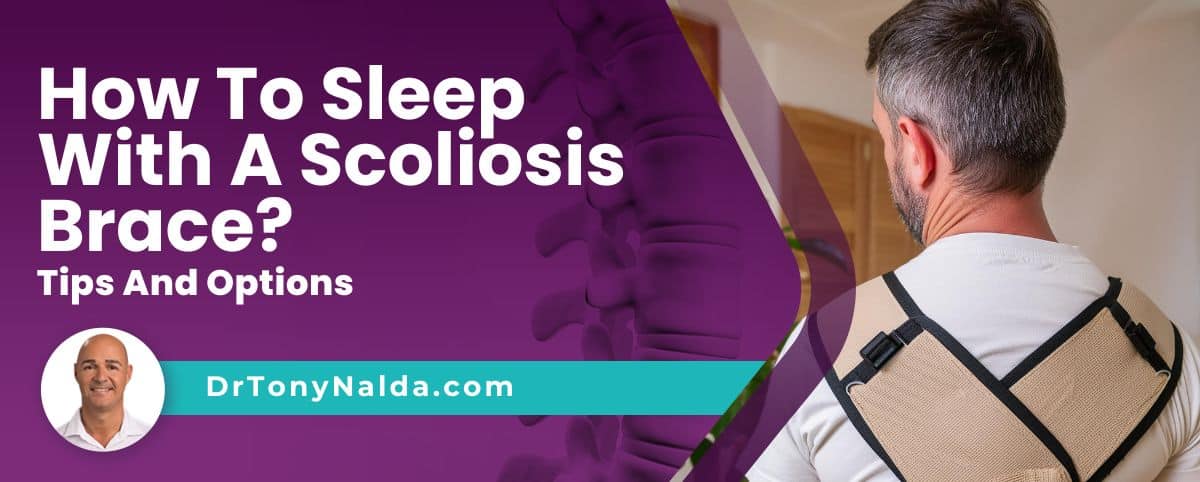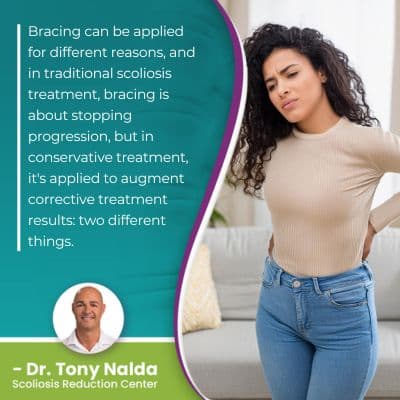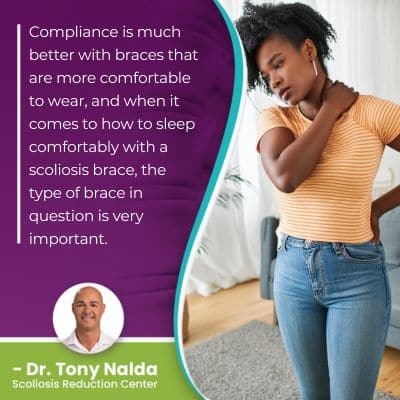How To Sleep With A Scoliosis Brace? Tips And Options

Brace efficacy is based largely on compliance. Regardless of the brace's design, if it's not worn exactly as prescribed, it won't be effective, and braces that are prescribed for full-time wear can mean they have to be worn for up to 23 hours a day, so this includes sleeping with the brace.
Different braces have different goals and designs that impact their efficacy and comfort. When it comes to how to sleep with a scoliosis brace, mass-produced rigid traditional scoliosis braces tend to be less comfortable than modern corrective braces.
Different braces function differently because of their design and treatment goal and they're tied to divergent scoliosis treatment approaches.
Table of Contents
Scoliosis and Bracing
Being diagnosed with scoliosis means an unnatural side to side spinal curvature that also twists has developed, and this introduces a lot of uneven forces to the spine, its surrounding muscles, nerves, and the entire body.
Scoliosis treatment is important because as a progressive condition, the nature of scoliosis is to get worse over time, and while we don't know why most cases of scoliosis develop initially, we do know what causes them to progress: growth spurts.
So while scoliosis affects all ages, childhood scoliosis should be taken seriously because they are the most at risk for rapid-phase progression, particularly in the condition's most-prevalent type, adolescent idiopathic scoliosis, diagnosed between the ages of 10 and 18.
Rapid and unpredictable growth spurts can trigger scoliosis to get worse, and that means the size of the unnatural spinal curve is increasing, as are the condition's uneven forces, and their effects.
 So a focus of childhood scoliosis treatment is on working towards a significant curvature reduction to counteract the constant trigger of growth, and as bracing can be particularly effective on growing spines, it's a regular facet of treatment for childhood scoliosis.
So a focus of childhood scoliosis treatment is on working towards a significant curvature reduction to counteract the constant trigger of growth, and as bracing can be particularly effective on growing spines, it's a regular facet of treatment for childhood scoliosis.
Bracing is also used in the treatment of adult scoliosis, but the focus is different both in treatment in general and in bracing.
Bracing can be applied for different reasons, and in traditional scoliosis treatment, bracing is about stopping progression, but in conservative treatment, it's applied to augment corrective treatment results: two different things.
Traditional Scoliosis Treatment and the Boston Brace
Traditional scoliosis treatment focuses on stopping progression; it offers a more reactive approach because it doesn't have a strategy for addressing scoliosis while mild, and is more about observing while conditions are mild, applying bracing at the moderate level, and recommending surgery if a patient becomes severe.
The boston brace is the most commonly-used brace in traditional scoliosis treatment, and despite the brace being first designed in the '70s, it's changed very little over the years.
The boston brace is mass produced so is not fully customized to suit a patient's individual body/condition type.
Braces are often prescribed for full-time wear, and this can mean anywhere from up to 23 hours a day for up to 5 years, or until growth has stopped in childhood scoliosis.
The boston brace works by squeezing the spine into a straighter position, but this type of squeezing pressure is known to weaken the spine over time, and in addition, the boston doesn't address the condition's rotational component, so is already limited in its potential efficacy because scoliosis is a 3-dimensional condition and needs to be addressed as such.
So because of its squeezing design and being made from rigid plastic material, it's cumbersome and uncomfortable to wear, and this is the main challenge with bracing as scoliosis treatment: compliance.
So individuals trying to sleep with a Boston brace are unlikely to find it comfortable, regardless of sleep position, but fortunately, as modern conservative scoliosis treatment evolved, so too did our understanding of scoliosis and brace efficacy.
Conservative Scoliosis Treatment and the ScoliBrace
Conservative scoliosis treatment is modern and offers a nonsurgical treatment alternative; it also offers a different proactive approach to treating scoliosis.
Conservative treatment is proactive because it's started as close to the time of diagnosis as possible, and this is because the focus of treatment is working towards preventing progression, increasing condition severity, and the need for surgical intervention in the future.
Conservative treatment is started when it's most likely to be successful, and while there are never treatment guarantees, there are a number of benefits associated with early diagnosis and early intervention.
Scoliosis only gets more complex to treat the more it progresses, hence the benefit of proactive treatment applied early in a condition's progressive line.
Conservative treatment relies on the ultra-corrective ScoliBrace which represents the culmination of what we've learned over the years about scoliosis and bracing efficacy.
The Scolibrace is custom-designed to address the specifics of each patient's body and condition type, so they are more comfortable to wear, and in addition, are made from flexible material.
The ScoliBrace also has correction as its end goal and works by pushing the spine into a corrective position, instead of squeezing so is more comfortable during regular wear, and to sleep in.
Compliance is much better with braces that are more comfortable to wear, and when it comes to how to sleep comfortably with a scoliosis brace, the type of brace in question is very important.
In the end, customization means a more comfortable brace that's less bulky and cumbersome to wear, and that also means a brace that's more comfortable to sleep in and wear full-time.
Who Needs a Scoliosis Brace?
 No single brace on its own is powerful enough to correct scoliosis, but when combined with other types of corrective treatment, it can help complement other treatment disciplines so conditions can be impacted on multiple levels.
No single brace on its own is powerful enough to correct scoliosis, but when combined with other types of corrective treatment, it can help complement other treatment disciplines so conditions can be impacted on multiple levels.
Not only are there different severity levels of scoliosis, there are also different condition types, and scoliosis affects all ages; the most prevalent type being adolescent idiopathic scoliosis, diagnosed between the ages of 10 and 18.
For adolescents, they don't want to stand out, walk differently, or look different from their peers, and that's what a scoliosis brace does, particularly when prescribed for full-time wear.
Bracing is particularly effective on growing spines as they are more flexible so is a regular facet of treatment in childhood scoliosis, and particularly with adolescents because they are the most at risk for rapid-phase progression due to the growth spurts of puberty: growth is what triggers progression.
When bracing is used to treat adult scoliosis, the focus is different; the curvature reductions can be smaller because they don't have to counteract the constant trigger of growth.
As scoliosis doesn't become a compressive condition until skeletal maturity has been reached, that's when it becomes painful, so a focus of adult scoliosis treatment is to work towards reducing the size of an unnatural spinal curve, but back to where it was prior to becoming painful.
Bracing for adults is more about short-term pain management and increasing spinal stability than it is about augmenting corrective treatment results in children.
Conclusion
So how to sleep with a scoliosis brace is more about finding the right brace than about finding a good sleeping position, and part of that is finding the best possible treatment option.
When it comes to getting a good night's sleep with a scoliosis brace, make sure the chosen treatment approach and the type of brace it applies is customized, corrective, and modern.
Modern corrective bracing is more comfortable, less bulky, and represents the culmination of what we've learned about bracing efficacy over the years; the ScoliBrace addresses many of the shortcomings associated with traditional bracing, including compliance.
No brace has a chance of being effective it it's not work precisely as it's prescribed, and if that includes full-time wear, that means sleeping in the brace, and if a traditional brace is rigid, bulky, and uncomfortable, not only are adolescents not going to want to wear them at school, they're also unlikely to find them comfortable enough to sleep in: compliance is key.
As part of a proactive and modern conservative treatment approach, a corrective brace can be worn during sleep because it's customized, so rates of compliance are better, and as the brace works by pushing the spine instead of squeezing it, it's not associated with breathing problems and weakening the spine.
So here at the Scoliosis Reduction Center, where patients benefit from a modern proactive conservative treatment approach, that includes access to the ultra-corrective ScoliBrace.
The ScoliBrace is more comfortable to wear and sleep in because it's customized, and as compliance is the main issue challenging brace efficacy, knowing the type of brace, along with its aligned treatment approach to commit to is key.
Dr. Tony Nalda
DOCTOR OF CHIROPRACTIC
After receiving an undergraduate degree in psychology and his Doctorate of Chiropractic from Life University, Dr. Nalda settled in Celebration, Florida and proceeded to build one of Central Florida’s most successful chiropractic clinics.
His experience with patients suffering from scoliosis, and the confusion and frustration they faced, led him to seek a specialty in scoliosis care. In 2006 he completed his Intensive Care Certification from CLEAR Institute, a leading scoliosis educational and certification center.
About Dr. Tony Nalda
 Ready to explore scoliosis treatment? Contact Us Now
Ready to explore scoliosis treatment? Contact Us Now





